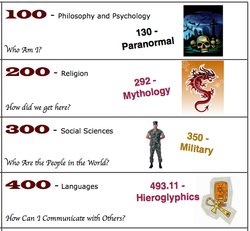5.1 Collections
Candidates organize school library collections according to current library cataloging and classification principles and standards.
2010 ALA/AASL Standards for Initial Preparation of School Librarians
In the course, Organization and Access, SLM502, we were tasked to consider the needs of students at different age and ability levels. Then we created shelf labels and guides to help students navigate the library efficiently and to access the information they needed. On the shelf labels, I added visual representations to help students with a lower reading ability or language barrier access the information. For each level, I analyzed the interests of the students by interviewing different age levels on my children’s swim team and the curriculum areas are directly from the Common Core standards. In my media center, I will create these labels specific to the high interest areas and curriculum needs of my specific community. While organizing this assignment, I discovered that the Brooklyn Children’s Museum has created questions that encompass the major divisions of the Dewey decimal system that help make it more accessible to children. For example, the 700’s (Arts & Recreation) are referred to by the question, “How can I enjoy my free time?” and the 300’s (Social Sciences), “Who are the people in the world?” In the future, I plan to use these questions to guide students towards their information needs. I plan to create a lesson where students take keywords from a specific research question to place it under the umbrella of one of the big ten questions to try to predict the first Dewey number.
The second assignment was much more difficult for me. We were asked to create original MARC records for a collection of ten books. While I’ve been fascinated by the Dewey Decimal System since childhood, I did not know what MARC records were until this class. It is a system that allows computers to interpret a card catalog – effectively creating the databases we use today to locate resources in a library collection. I had no idea how much there was to consider, down to measuring each book with a ruler! We used a web-based program called MARC Magician and I quickly learned to create a template of my most commonly used fields. Once I understood the fields, I learned I would need to conduct research beyond the information printed in the books themselves. Author’s birthdate, awards the book had won, and curriculum connections are not always included on the back cover or inside publication pages, but should be included in a MARC record. The subject headings needed to be created with my specific community in mind. I needed to consider what keywords a student might use to search for subject. Making this an area that I’d want to pay more attention to, in order to ensure access. I choose a nice variety of materials to complete this assignment in a way that let me learn the most about the MARC fields. I also think recording my thought process along the way was also a great way to absorb the information. I’m very happy that most cataloging is done for the librarian. It is not especially difficult once you understand the system, but it is especially tedious. I have great respect for those catalogers of the past that had to hand-write card catalogs. I am glad I will be able to catalog when I need to, it won’t be as intimidating. The “cheat sheet” that I made myself with explanations of the major fields will be something I laminate and keep close both for reading and for creating MARC records – especially when I am new.
The second assignment was much more difficult for me. We were asked to create original MARC records for a collection of ten books. While I’ve been fascinated by the Dewey Decimal System since childhood, I did not know what MARC records were until this class. It is a system that allows computers to interpret a card catalog – effectively creating the databases we use today to locate resources in a library collection. I had no idea how much there was to consider, down to measuring each book with a ruler! We used a web-based program called MARC Magician and I quickly learned to create a template of my most commonly used fields. Once I understood the fields, I learned I would need to conduct research beyond the information printed in the books themselves. Author’s birthdate, awards the book had won, and curriculum connections are not always included on the back cover or inside publication pages, but should be included in a MARC record. The subject headings needed to be created with my specific community in mind. I needed to consider what keywords a student might use to search for subject. Making this an area that I’d want to pay more attention to, in order to ensure access. I choose a nice variety of materials to complete this assignment in a way that let me learn the most about the MARC fields. I also think recording my thought process along the way was also a great way to absorb the information. I’m very happy that most cataloging is done for the librarian. It is not especially difficult once you understand the system, but it is especially tedious. I have great respect for those catalogers of the past that had to hand-write card catalogs. I am glad I will be able to catalog when I need to, it won’t be as intimidating. The “cheat sheet” that I made myself with explanations of the major fields will be something I laminate and keep close both for reading and for creating MARC records – especially when I am new.

This portfolio and the artifacts contained herein by Amy Soldavini are licensed under a Creative Commons Attribution-NonCommercial-ShareAlike 3.0 Unported License |
Revised July 2013

